Cereals have been the basis of human nutrition for many centuries. Recipes for making porridge, a traditional cereal dish, have also evolved over the centuries.
Porridge is enjoyed by both children and adults. It is nutritious, with lots of minerals and vitamins. Porridges are suitable for both a healthy diet and a dietary one.
This product is also convenient because it can be stocked in the right quantities. Therefore, the question has always been relevant: how to store cereals so that they do not lose their beneficial properties?
General requirements for the organization of storage of cereals
It is almost impossible to create ideal conditions for the long-term storage of cereals in an apartment. Groats should be stored from +5 to -5 degrees, with a humidity of about 60%. Under such conditions, they are stored for up to 2 years, crushed, and ground into flour for only up to 3 months.
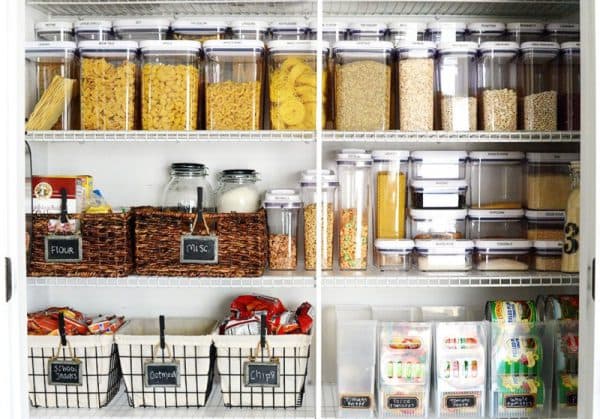
This is how cereals can be stored in the kitchen
But usually, cereals bought in a store are stored at room temperature. Such storage reduces the nutritional quality. Under these conditions, it is better to calculate the stocks of cereals for a month. Storing vegetables in containers in the kitchen is the best solution, but what about cereals?
It is allowed to store semolina, buckwheat, flour, rice for up to six months, any cereals and wheat groats are stored for only two months. Polished rice is successfully stored for a year.
But for so long, cereals must be stored correctly, observing certain conditions:
- in the room is not allowed a sharp temperature drop and high humidity;
- you can’t put dried fruits nearby, bugs can spread from them to the cereal;
- to prevent the appearance of bugs, it is necessary to subject the cereal intended for storage to processing: you can bake it in the oven for 5 to 10 minutes or place the bag in the freezer;
- after buying the cereal, it is worth sorting out to make sure there are no bugs;
- cereals should be viewed once a month;
Do not leave in store and factory packaging, when packaging, moisture and insects could get there.
Many housewives put a clove of garlic, a dry lemon peel on the surface of the cereal, and leave an ordinary tablespoon of food metal in the flour.
In plastic bags
If the cereal was bought in a store in a plastic bag, and it is planned to store it in this type of packaging in the future, then it is worth pouring it into a new bag. In this form, you can store cereals both in cupboards and small sofas for the kitchen.

Storage of cereals in bags in the kitchen
But storage in such packages is not recommended, the cereal in them can “suffocate”, the process of debate begins. The product acquires an unpleasant taste and smell. The package may break and the cereal crumble. They absolutely cannot store flour.
In linen bags
This is how our grandmothers and great-grandmothers saved cereals. Before pouring cereal into the bag, it must be boiled in a salt solution. In such bags, there is good air circulation, and the salt prevents the formation of mold. Bags must be tightly tied. They are also convenient in that they can be put in a closet or chest close to each other and embroidered or sewn to them with a note with the name of the cereal. Some of them can be stored in a wooden bread box.

Storage of cereals in linen bags
If there are few bags, and they are designed to store from 2 to 3 kilograms, then you can install a long narrow box in the kitchen cabinet and place the bags in it, and sign the name of the cereal right next to the desired bag on the box.
In wooden chests and boxes
Wooden chests were a traditional place for storing cereals and flour. They have always helped not only to preserve products but also solved the problem of storage space. Chests were most often installed in pantries, hallways, and kitchens.
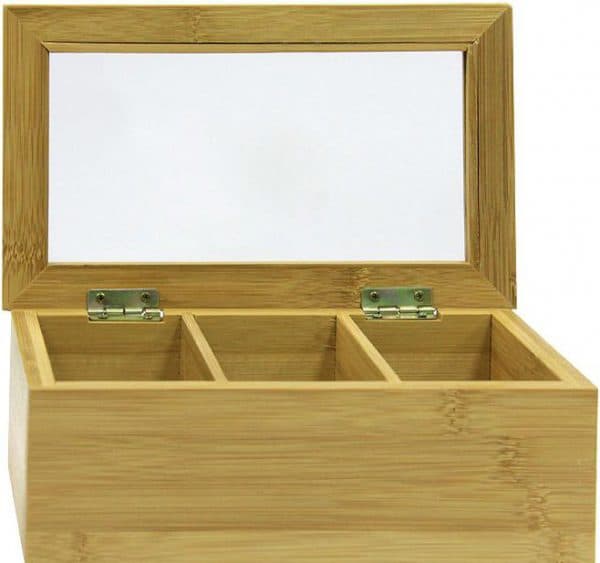
Storage of cereals in wooden chests
They were hinged, mounted on the wall, or installed on the floor, in shape they resembled a long chest with a lid on top. In one lari, cereals and flour were poured directly without additional packaging, they were with carefully fitted walls and did not have even the slightest cracks. Each type of product was poured into a separate chest.
Or the chest had several compartments, sometimes each compartment had its own lid. But most often chests were used, where different types of cereals were placed, usually packed in small linen bags.
The advantage of this storage is that in such chests the cereals do not get moldy for a long time, do not “suffocate” and become less damp, especially if the chest itself is in a dry room. The chest is also convenient because all the cereals can be concentrated in one place, so it is more convenient to control their presence and safety.
And now many housewives prefer this method of storage. But in the manufacture of such a chest, one must remember that it cannot be varnished and smelled with paints. Chests are also convenient because when they are installed in the kitchen or in the corridor, they can serve as a place to sit, if they are low, they can be covered with a sewn upholstered seat, put decorative pillows. High chests or chests mounted on the wall can be an additional work surface. And how to choose knives for the kitchen can be read here.
In addition to chests for storing cereals, boxes were also used. They are traditionally made from boards, plywood, and birch bark, wicker.
The boxes are made tall; they serve to store large bags of cereals and flour. Canvas and linen bags are placed in the box tightly to each other. Wooden boxes are closed with a lid and are also used as furniture, while wicker boxes are used as a decorative element.
In glass jars
Mistresses believe that such storage is most convenient:
- jars come in different sizes;
- Storage in glass jars
- they can be tightly closed;
- it is convenient to pour out the amount necessary for cooking;
- can be neatly placed on a shelf in the closet;
- through the glass you can see which cereal is stored in the jar;
In a tightly closed jar, cereals retain their taste for longer, are less affected by a bug.
spice requirements.
With proper storage, spices and spices do not lose their taste for up to five years.
Spices are in every home. And each housewife has her own storage methods, often suggested by her mother or grandmother.
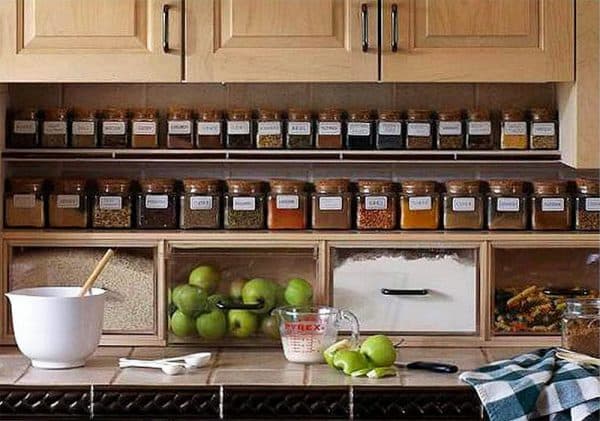
Storing spices in the kitchen
There are a few general points when storing spices for a long time:
- their taste changes under the influence of light;
- place jars of spices as far as possible from the heat source;
- spices should be stored in glass or clay containers;
- if moisture gets into the jar, spices can rot;
- spices in the form of bulbs and roots are best stored in wooden or woven birch bark containers; Learn more about microwave utensils here.
- fresh herbs are well preserved in the freezer;
- all seasonings easily absorb odors;
- spices, if possible, should be crushed immediately before use;
- Chili peppers and red peppers are best stored in an airtight container in the refrigerator.
- do not open a jar of spices over the stove at the time of cooking: steam can get into it.
Often seasonings are placed on a shelf above the stove, this is not worth doing, the containers are constantly heated by steam, and if there is even the slightest access to air, then the steam will get inside in the form of a liquid.
In sachets
Most spices can be placed in such bags, but they must be hermetically sealed. The shelf life with this option is reduced to a year. It is most convenient to place spicy herbs that are stored in the freezer in plastic bags.
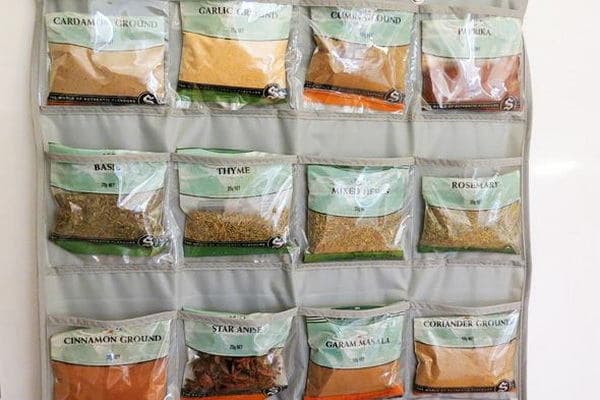
Storing spice bags in the kitchen
The advantage of such storage is that odors and moisture do not penetrate into the packaging.
In paper bags
In this form, it is convenient to store vanilla, cinnamon. Different types of peppers can be stored in paper bags for up to a month. With longer periods, they cake and lose their flavor.

In paper bags in the kitchen
For such bags, you can sew special pockets and hang them one under the other on the kitchen cabinet door.
In banks
In this way, it is most convenient to store all types of ground spices and spices.
Here are some ideas for this option:
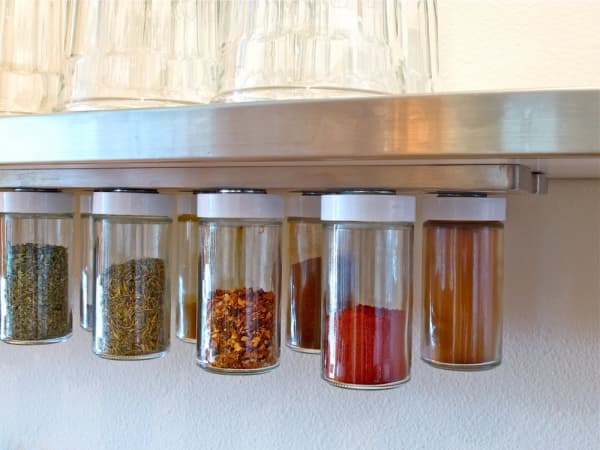
Bank storage
- jars of spices are placed in the cabinet doors;
- or placed in a drawer with compartments that slides out easily;
- now it is fashionable to store spices on open shelves, attach jar lids with magnets to the refrigerator or to a special magnetic board above the work surface, in this case, you need to choose places where the sun’s rays do not fall;
- they arrange a narrow retractable whatnot on wheels, which is placed between the wall and the cabinet or the wall and the refrigerator. And about crafts and decor ideas for the kitchen can be found in this article.
other methods
It is possible to install square or rectangular containers with lids in a thick cardboard or plastic box, a wooden box and pour spices into it.
Each house has its own storage methods, proven by many years of practice. To what has already been said, you can add a few more simple ways invented by zealous housewives:
- plastic bottles: grits are poured through the neck and the lid is screwed tightly; bottles are compactly stacked on top of each other according to the principle of a woodpile on a shelf in a closet;
- for a large amount of product, this method is suitable: pour cereal or flour into a plastic bucket, close the lid tightly and secure the lid with a rubber band for the ears of the handle.
A rare dish can be prepared without seasonings. But some housewives completely manage only with black peppercorns and bay leaves, while others collect a whole collection. And all this, too, must be stored.
Properly organized storage of spices and cereals makes it possible to stock up for a long period and protect products from spoilage and insects. How to equip a small kitchen can be found in this material.

